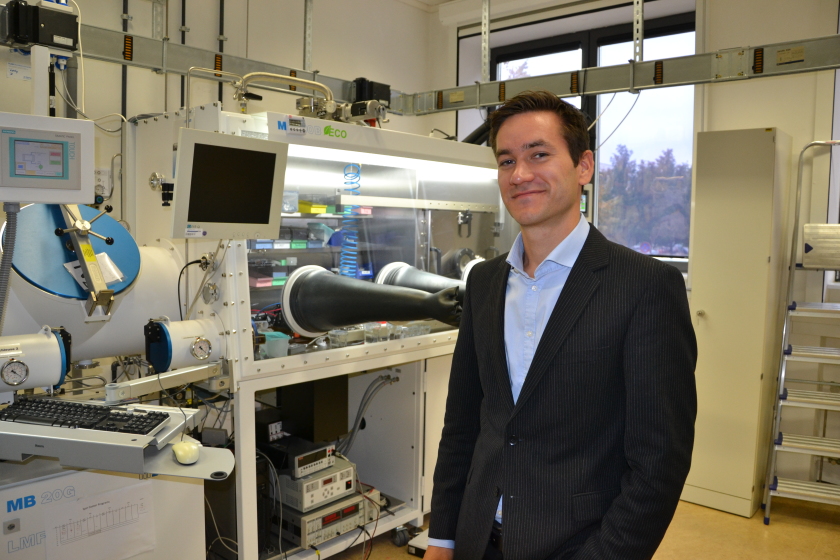Steve Albrecht is Junior Professor at the Technical University of Berlin

Steve Albrecht is heading the junior investigator group "Perovskit Tandem Solar Cells" at the HZB. © A. Kubatzki/HZB
The Technische Universität Berlin (TU) and the Helmholtz-Zentrum Berlin (HZB) have appointed Prof. Dr. Steve Albrecht to the joint junior professorship "perovskite solar cells" as of December 15, 2018. Since 2016, Albrecht has headed the junior investigator group "Perovskit Tandem Solar Cells" at the HZB, which is funded by the Federal Ministry of Education and Research.
With his team of 11, Albrecht researches and develops tandem solar cells that combine the advantages of silicon and perovskite solar cells. If both materials are combined to tandem solar cells, a larger part of the light spectrum can be converted. This increases efficiency. The junior research group recently succeeded in increasing the efficiency of perovskite silicon tandem solar cells to 25.5 percent.
Steve Albrecht will also take on teaching responsibilities at the TU Berlin as part of his junior professorship, including supervising a perovskite internship for students at the HZB.
Albrecht studied and completed his PhD in physics at the University of Potsdam. For his dissertation on organic solar cells he was awarded the Carl Ramsauer Prize of the German Physical Society and the Young Investigators Prize of the Leibniz-Kolleg Potsdam.
At the end of 2014, Albrecht joined the HZB as a postdoctoral researcher and established the research field perovskite solar cells at the center. In 2017, together with Eva Unger, he was in charge of setting up the infrastructure for the HySPRINT Perwoskit Laboratory at the HZB. Today, 40 users work here, producing and characterizing perovskite layers for solar cells using various techniques and methods.
(sz)
https://www.helmholtz-berlin.de/pubbin/news_seite?nid=20260;sprache=en
- Copy link
-
How carbonates influence CO2-to-fuel conversion
Researchers from the Helmholtz Zentrum Berlin (HZB) and the Fritz Haber Institute of the Max Planck Society (FHI) have uncovered how carbonate molecules affect the conversion of CO
2 into valuable fuels on gold electrocatalysts. Their findings reveal key molecular mechanisms in CO
2 electrocatalysis and hydrogen evolution, pointing to new strategies for improving energy efficiency and reaction selectivity.
-
Peat as a sustainable precursor for fuel cell catalyst materials
Iron-nitrogen-carbon catalysts have the potential to replace the more expensive platinum catalysts currently used in fuel cells. This is shown by a study conducted by researchers from the Helmholtz-Zentrum Berlin (HZB), Physikalisch-Technische Bundesanstalt (PTB) and universities in Tartu and Tallinn, Estonia. At BESSY II, the team observed the formation of complex microstructures within various samples. They then analysed which structural parameters were particularly important for fostering the preferred electrochemical reactions. The raw material for such catalysts is well decomposed peat.
-
Helmholtz Investigator Group on magnons
Dr Hebatalla Elnaggar is setting up a new Helmholtz Investigator Group at HZB. At BESSY II, the materials scientist will investigate so-called magnons in magnetic perovskite thin films. The aim is to lay the foundations for future terahertz magnon technology: magnonic devices operating in the terahertz range could process data using a fraction of the energy required by the most advanced semiconductor devices, and at speeds up to a thousand times faster.
